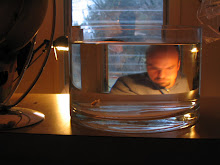 'By and large, objects made by groups look more or less alike because, in order to articulate certain purposes, some persons are taught or trained in similar techniques to make similar objects, much as some are taught or trained in traditions of poetry or music to make certain kinds of poetry or music.'
'By and large, objects made by groups look more or less alike because, in order to articulate certain purposes, some persons are taught or trained in similar techniques to make similar objects, much as some are taught or trained in traditions of poetry or music to make certain kinds of poetry or music.'-David Summers
Yes, sure, that sounds fair. But why, really, stop there? Couldn't we also say, wonders the father who has now read Good Night Moon aloud more than 50 times, that the thoughts thought, and the words used, by groups are more or less alike because our toddlers are taught and trained using a relatively narrow shared band of examples?
Farm animals, jungle animals, shapes, and numbers. Mommies, daddies, brothers, and sisters. Head, shoulder, knees and toes. Stars and the moon; cars, trains, and planes. There is a common currency of images used, I think, in some combination by nearly every contemporary American family.
Which is fine. But it also makes me wonder: what are we leaving out, and why? Why not images, in board books, of elms, and pines, and cedars, and oaks? Why do we still point, over and over, to the cows and pigs that might well have been standard features of a 19th-century Illinois-born childhood, but that have given way to billboards, stoplights, and yield signs? Why does Richard Scarry include, in What Do People Do All Day?, images of bakers and road-builders, but nothing on fashion designers, or diamond miners?
Idle questions, perhaps. Perhaps - but the other evening, as Cleo and I looked up at the early night sky, I pointed to the only light visible above us, and baldly lied: star, I said, knowing full well that it was a planet. We teach children, of necessity, a manageable band of concepts. But those concepts may reflect our own preoccupations and wishes more than they do our child's needs, or the world's actual form. Children are trained and taught, and the world begins to look the same, instead of beautifully diverse.
Farm animals, jungle animals, shapes, and numbers. Mommies, daddies, brothers, and sisters. Head, shoulder, knees and toes. Stars and the moon; cars, trains, and planes. There is a common currency of images used, I think, in some combination by nearly every contemporary American family.
Which is fine. But it also makes me wonder: what are we leaving out, and why? Why not images, in board books, of elms, and pines, and cedars, and oaks? Why do we still point, over and over, to the cows and pigs that might well have been standard features of a 19th-century Illinois-born childhood, but that have given way to billboards, stoplights, and yield signs? Why does Richard Scarry include, in What Do People Do All Day?, images of bakers and road-builders, but nothing on fashion designers, or diamond miners?
Idle questions, perhaps. Perhaps - but the other evening, as Cleo and I looked up at the early night sky, I pointed to the only light visible above us, and baldly lied: star, I said, knowing full well that it was a planet. We teach children, of necessity, a manageable band of concepts. But those concepts may reflect our own preoccupations and wishes more than they do our child's needs, or the world's actual form. Children are trained and taught, and the world begins to look the same, instead of beautifully diverse.




No comments:
Post a Comment